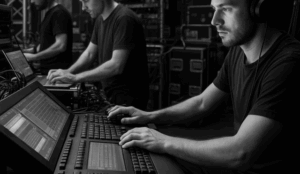One of the most important aspects of organizing an event is choosing the right audio, video, and lighting equipment. Whether it’s a small corporate meeting, a large concert, or an online event, selecting the appropriate gear is crucial to ensure the event runs smoothly and that the audience remains engaged and satisfied.
In this guide, we’ll show you the key points to consider when choosing the equipment best suited to your specific needs, depending on the type of event.
Understanding the Type and Requirements of Your Event
Before diving into audio, video, and lighting equipment details, it’s essential to understand what type of event you are organizing and what your specific needs are.
- Number of attendees: The size of the audience influences the power and type of audio, video, and lighting equipment needed.
- Type of event: Whether it’s a concert, a conference, or a theatrical performance, each event requires specific equipment for success.
- Venue: The size and shape of the venue affect the choice of sound systems, microphones, cameras, screens, and lighting. Outdoor venues, for instance, require weather-resistant equipment.
It’s important to clarify the number of participants, the venue, the type of multimedia content to be shown (music, video, etc.), and the desired level of audience interaction. For example, a live streaming or MICE event will need different technical solutions compared to a live concert.
Choosing Audio Equipment
Microphones
The right microphone depends heavily on the type of event. For a conference, lapel microphones that free the speaker’s hands may be preferred, while dynamic microphones are better suited for live concerts because they capture direct sound and handle varying sound pressure levels. These are ideal for outdoor events as they isolate environmental noise. For indoor events or those requiring high-quality vocal reproduction, condenser microphones provide clear and detailed sound.
Audio Mixers
A quality mixer allows you to control levels, tones, and sound dynamics. Modern digital mixers offer advanced features and can store settings and integrated effects, particularly useful for complex events with multiple audio sources.
Sound Systems
Speakers should be chosen based on the size of the venue and the type of event. It’s important that the speakers cover the entire event area without leaving “dead zones.” For outdoor events, exhibitions, or large setups, powerful, directional speakers are recommended. For indoor corporate events, high-quality but more discreet speaker systems may be ideal. Outdoor speakers should have weatherproof certifications.
Choosing Video Equipment
Screens and Projectors
Selecting the right screen is critical. For outdoor events or concerts, large LED screens are ideal because they remain highly visible even in bright conditions. For conferences and seminars, projectors or high-brightness monitors may be more suitable. Consider using multiple screens to ensure good visibility from all angles, especially in large venues.
Cameras
For excellent image quality, HD or 4K cameras are recommended. For recording events or live streaming, the choice depends on the desired resolution and features such as optical zoom or image stabilization. Depending on the venue and type of event, multiple cameras may be used to capture various angles and perspectives.
Choosing Lighting Equipment
Lighting plays a fundamental role in creating the atmosphere and overall event experience. The right lighting can make the difference between a memorable event and one quickly forgotten.
Factors to Consider:
- Event type: The type of event greatly influences lighting needs. A concert requires very different lighting than a conference or wedding.
- Venue size: Larger spaces need more powerful lighting and a higher number of units.
- Budget: Your budget affects the quality and quantity of equipment you can rent or purchase.
- Aesthetic elements: Lighting can create specific visual effects and highlight architectural or decorative features.
Types of Lights:
- PAR lights: Versatile fixtures available in various colors, controllable via DMX.
- Strobe lights: Create flashing effects for energy and excitement.
- Moving heads: Motorized lights that can rotate and tilt for dynamic and complex effects.
-
LED lights: Energy-efficient, long-lasting, available in multiple colors and styles.
The Importance of Audiovisual Direction
Good audiovisual management is crucial for coordinating sound and video during an event. It can make the difference between a simple event and an engaging experience for the audience. Emergenze Sonore provides professional AV direction with highly qualified technicians capable of managing audio, visuals, and lighting in real time, ensuring a smooth and polished presentation.
Practical Tips for Equipment Rental
- Evaluating suppliers: Choose a reliable supplier like Emergenze Sonore for high-quality equipment and technical support. Consider reputation, customer reviews, and industry experience.
- Testing equipment: Test the equipment before the event to ensure compatibility and proper functioning.
- Technical support: Ensure the supplier provides on-site technical assistance to quickly resolve any issues.
Choose Emergenze Sonore for Your Event
Selecting the right equipment is fundamental to the success of any event. Emergenze Sonore provides audio, video, and lighting rental solutions for all types of events, with or without technical support. Contact us today to find out how we can help make your event an unforgettable experience.



